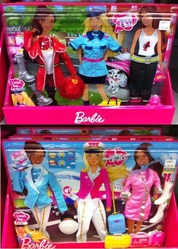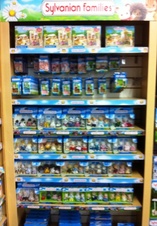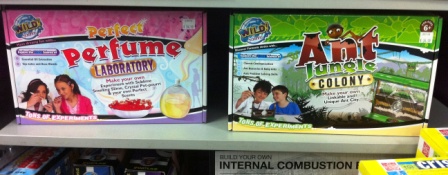|
I have fond memories of my collection of childhood toys - wooden blocks, Big Ted, My Little Pony, the Cindy doll my parents bought me (instead of the Barbie I REALLY wanted), Lego, railway tracks... And nowadays I enjoy sometimes escaping into the imaginary world with my four-year-old boy and his collection of treasured toys. I read about the toys on offer for kids, I see kids playing with toys and the students I work with tell me about the toys that are and were important in their lives. There is a lot of writing about the highly gendered and also sexualised nature of many childhood toys these days, but on Friday I suddenly realised that I could count on one hand the number of times I have been in a toy store since entering adulthood. Inspired by other writers, I decided it was time to hit the front-line. What was on offer for New Zealand children? Was it as bad as it was in the USA? (where much of the research I read comes from) And what are the 'good' options out there? Armed with my camera, I entered our local toy store (one of a nationwide chain). And thus began an hour of walking up and down every aisle, taking note and photographing the good, the bad and the plain downright ridiculous. Into 'GIRL ZONE'  Upon entering the store, the first thing I noticed was that there was an area labelled ‘Girl’s Zone’, but the only other zone to be labelled was 'Pre-school'. Is this because all the other toys in the store are designed for boys (the default ‘normal’), or is it that all the other toys are for both boys AND girls but this wee corner is for girls only? I headed over to investigate further and was nearly blinded by the pink-ness. First up, the Barbie display...  "Hmmm, who do I want to be today?" I had high hopes for the Barbie 'I Can Be..." range. I recall as a child in the 1980s Barbie was a real 'girls can do anything' kinda gal, so I thought that surely by 2012, any remnants of that 1952 original passive doll would be well and truly banished. Unfortunately it seems that Barbie's career options in 2012 are very limited to what she can do whilst still wearing form-fitting lycra and/or heels. And the ubiquitous pink of course. There were five career options in the character dolls (see below) - I challenge anyone to find me any real-life professional woman whose wardrobe resembles any of these outfits?! And as someone who spent my teen years as a surf lifeguard, it sure as hell didn't resemble this Barbie scene. A friend was telling me recently that she had relented and had promised her daughter a Barbie as long as she could find one doing 'normal' things - such as snowboarder Barbie. There wasn't a snowboarder Barbie in this shop, but I can envisage her ensemble already...  And if you wanted to simply give your exisiting Barbie a new career, you had six different outfits to choose from. As you would never guess the occupations from their outfits, let me label them top to bottom, left to right:
Next to Barbie was the much criticised new line of Lego, designed especially for girls - the 'Friends' range. Their catch-phrase is "The Beauty of Building" - because we wouldn't want girls to forget for a moment that regardless of the activity, it always comes down to beauty, right?  Anyone for Disney Princess paraphernalia? I personally dislike this range from Lego. I dislike the emphasis on beauty and I hate that the 'Friends' range have totally different bodies to the 'standard' range - they have boobs and makeup. There is no way one of the 'Friends' would EVER want to play with a standard Lego boy or girl! It's problematic that in creating a specific 'girls' range, by default the rest of the Lego range becomes a 'boys' range, thus limiting girls' options. And the narrow range of activities and colours offered to the girls drives me nuts. There is absolutely no scientific evidence to indicate that girls have a natural inclination towards pastel colours. Lego is just playing into the pinkification of girl-world that serves to further the gender gap amongst children and thus increase the profits of those marketing things to children. Next up was the Disney Princess Zone. In a moment of marketing genius, this line was released in 2000 and now there are now more than 25,000 Disney Princess items and many other companies have jumped on board to create Princess-mania in girl world. Lyn Mikel Brown, co-author of Packaging Girlhood, is concerned by the the sheer dominance of princess culture: “When one thing is so dominant, then it’s no longer a choice; it’s a mandate, cannibalizing all other forms of play. There’s the illusion of more choices out there for girls, but if you look around, you’ll see their choices are steadily narrowing.” As I continued to wander round 'Girl's Zone' I found more and more pink washing, and more and more toys with come-hither eyes and sexy poses. What really struck me was how much some of these toys had changed since I was a girl. In my day 'My Little Pony' was a sweet chubby thing with demure eyes. Her latest incarnation is decidedly sexy, curvy and oh, those eyes. There were a few brands in 'Girl's Zone' that really stood out in a positive way: Venturing out of 'Girl Zone', I headed towards the 'Pre-school' zone... I was pleased to see the gender-neutral 'preschooler' sign, although interested in the offerings as many of the toys in the 'Girl's Zone' were aimed at the pre-school age group. This section gave the impression of being very gender-neutral, but upon closer inspection, many of the toys revealed themselves to be playing into tired gender stereotypes: However, there were also some great non-gender-limiting options: (No other 'zones' were labelled, so the following categories are ones that I have used) Puzzles and games Of all the different types of toys, I would have thought that this genre would have the least need to be gendered. Apparently not. I think the biggest issue with gendering things like this is that it strongly discourages cross-gender play. Unfortunately I feel that few four year old boys would want to play with the pinkified versions of these games. By then, for many boys the gender message has been well and truly absorbed. Outdoor toys  A WINNER from Little Tikes! Gender neutral packaging PLUS an image of a boy and a girl playing together! *calm down Rachel, keep in mind how ODD it is that this is so rare!* Building and Science Sets These were located in the area I think a child would describe as the 'Boys' Zone' (although there were no actual signs to indicate this). Alongside these sets seemed to be an overwhelming collection of toys based around themes of fighting and violence. As the mother of a little boy, I am disturbed by the messages these toys give him about what it means to be a man. I could not find a single toy in this area that depicted a boy or a man in a caring or nurturing role. Play is one way children learn about what it means to be an adult as they role-play with the toys provided to them. What are the consequences of raising a generation of boys whose understanding of manhood is based on ninjas, soldiers and Avengers? My little adventure into the toy store was both depressing and comforting.
Depressing because of the overwhelming number of gender-limiting options out there. I imagined my four year old son Sol being let loose in that store to explore and admire the toys available to him. He would be confronted with SO MANY gender-limiting stereotypes. He would be presented with a very clear picture of what it is to be a girl, and what it is to be a boy. Both of these definitions are very narrow, and he would quickly realise it was high time he dumped all of his female friends. I would label very few of the toys in this shop inherently "bad or "wrong", but it's the overwhelming message they present en masse, and also the stark reality of what is missing. I managed to find three images of girls and boys playing together IN THE WHOLE STORE. Research shows that cross-gender play in childhood increases the likelihood of more healthy romantic relationships in the teen years, yet it seems that marketers are doing all they can to prevent this. Comforting because I realised that, if I searched hard enough I could find toys and games that were not gender-limiting. There are options out there for parents willing to take the time to find them. Some companies are still marketing their product to both genders, and although many had fallen into the highly-gendered trap, a number still offered a 'gender neutral' option alongside their gendered stuff. For this, I am heartened, and this quote comes to mind: "Don't tell me where your priorities are. Show me where you spend your money and I'll tell you what they are." - James W. Frick Childhood lasts for such a precious short time, let's not shorten this further by placing limitations on who and what our children can be. Let's not allow the financial motivations of toy companies have any part in how our children define themselves. Let's give our children the time and the space to explore and experience their world without being limited to what pop culture dictates is "right" for their gender.
7 Comments
Jasmine
12/6/2012 02:46:06 am
I think you have skewed this far too much actually Rachel and it reads as though you are criticising any parent who has brought gender orientated toys for their kids. It is only stereotypified if you as the parent choose to buy into it - Who's says that boys won't go for pink anyway - I know several little boys who love pink and Barbies - look at the triplets who just died and their favourite colours and toys. And who decided that green and purple are gender orientated colours, I have always thought they were fairly neutral? The new lego range is great and I actually havent noticed the figures as we dont have any but I still vividly remember as a kid getting a lego set with flowers and a garden and it was by far better than the cars and vehicles in other sets - the toy companies are not brainwashing the children - they are marketing in response to what the children like. My girls have trains and cars and puzzles and all those things and I do agree the pink overload is fairly disgusting (including clothing) but you dont have to choose it. I remember having a discussion with you on FB several months ago about the dilemma I was facing because Mila wanted a Barbie and I hated them - you stuck up for Barbie so I researched them - there are actually heaps of Barbies in all sorts of professions not wearing skimpy clothing - obviously they dont sell very well so the toy store does not stock them. What about all the fantastic Shleich animals and the playmobil? These are both gender neutral and didn't get a mention? Its what my girls spend most days playing with. Most little girls LOVE pink but they all grow out of it - its just a stage - similar to the phase that litte boys go through when they love dinosaurs or cars. The whole princess/fairy stage for girls is grown out of a wonderful imaginary world of fairytales and magic - just like the superheros. We do not want to squash that. Here is a study which indicates there might be evidence to suggest that girls might be hardwired to like pink and its not just marketing.
Reply
Neda
15/6/2012 03:53:14 am
There's "a study that suggests that girls are hardwired to like pink"?? Are you kidding me. Blue used to be associated with females until the 1950s. Are you a marketing rep for Barbie or something. Completely disagree with you on every point!
Reply
Andy
12/6/2012 09:48:02 am
Hi Rachel, I couldn't agree more! I also hate the mass branding...it seems you can't even get a car anymore without it being Dora or Transformers or one of the 'Cars', likewise a train that's not Thomas and so on. The media machine is incredible, and I don't really like it, I have to say. My little girl is about to turn two and loves playing with her breakdown recovery truck (that her cousin left behind one visit). She loves to dance to anything and I recall one of my friends saying to me once 'I'm glad I've got two boys, because you can't wrestle with girls'. What nonsense!
Reply
12/6/2012 12:08:15 pm
(I am having problems posting a comment - think it's too long so I will re-post as two comments)
Reply
12/6/2012 12:08:49 pm
I am absolutely not against fairytales and Princesses. I am anti-limitation. (Although the Disney version is not OK – a whole other blogpost there, but Peggy Orenstein does a great job at explaining why - http://www.nytimes.com/2006/12/24/magazine/24princess.t.html?_r=1&pagewanted=all). As I said in my post, no toy is implicitly ‘bad’ in itself, it’s the over-all message en masse that toy stores give children. There is interesting research on how the way that children play is changing – as toys have become more branded (for example, Transformers lego, Disney princess empire) children tend to re-enact what they have seen on TV or what is prescribed on the themed Lego box, rather than a story from their own imagination and creativity.
Reply
Hi, Rachel. I caught some of your interview this morning on the radio. Agree the gendering of toys is a huge issue, especially if we let toys completely over-run our child's life. Aware, informed parents don't need to feel that commercialised toys are the only option for play. It's always about balance. Personally we buy very few toys so for us it is not of concern with gender stereotyping. Maybe if we all buy less of those toys we will see less of them on the shelves too. We have the odd pink or blue toy but my three kids are happier with exploring their world around them, simple toys such as blocks, sand, water play, lego (without instructions and packaging) make-believe play, or anything that allows them to use their imagination. Creative play is about open-ended toys that let them be the 'creator' not toys that dictate their play or worse still- gendering/stereotyping. As a parent and designer I write a blog that explores how we can nurture the creative mind of a child. www.childsmindinnovation.com
Reply
Mandy George
14/6/2012 09:36:32 pm
What the makers fail to realise is once the toys are home, kids in a multi-gender home will play with each other and play with the "wrong" gender toys. I have a son and a daughter, and while they have their own toys they will play with each others.
Reply
Your comment will be posted after it is approved.
Leave a Reply. |
AuthorRachel is a writer and educator whose fields of interest include sexuality education, gender, feminism and youth development. Archives
November 2023
Categories
All
|







































 RSS Feed
RSS Feed




